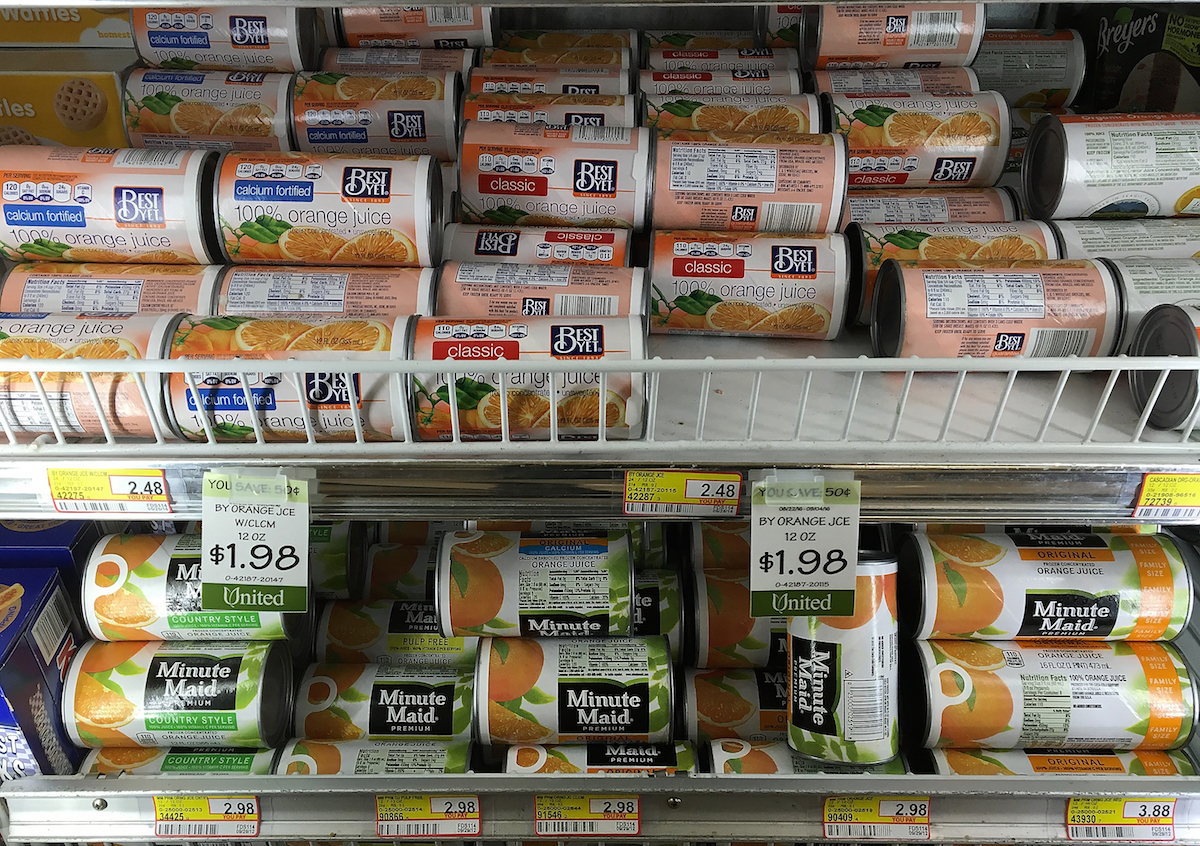
Every weekday morning between 1949 and 1954, at precisely 10:15 am, the golden-voiced singer Bing Crosby would start his hugely popular CBS radio show with some simple advice to the American housewife. Addressing his sidekick, Bing would query, “Ken, what’s the shopping hint for today?” And without fail, Ken would immediately reply, “Well, it’s Minute Maid Fresh Frozen Orange juice, ladies. And your frozen food store has it.”
Although O.J. is so common on modern American breakfast tables that it has become something of a cliché — complete with its very own backlash — back when Bing was doing his radio thing in the mid-20th century, the idea of drinking once-frozen orange juice was “nothing short of sensational.” The post-World War II economic boom meant more households could now purchase electric refrigerators for their home and companies like Birdseye Foods and Snow Crop were wowing cooks with frozen vegetables that tasted fresh. But, amid the frozen foods boom, frozen orange juice was a true “Cinderella” product.
Frozen orange juice itself as a concept was certainly not new. Since at least the 1930s, citrus farmers in Florida and California had been juicing their wares, packing them into cans, freezing them, and then shipping them off to middle America. Unfortunately for drinkers far from citrus country, almost immediately after a can of frozen orange juice left the farm it started to lose all resemblance to actual orange juice. For reasons unknown to chemists, the drink’s essential oils would begin to degrade and what was once a tart and refreshing beverage quickly transformed into a discolored orange glop. “Cooked” is how one researcher described it; reminiscent of turpentine, claimed another.
United States Department of Agriculture (USDA) scientists and agricultural cooperatives had been hard at work trying to resolve this orange juice issue all throughout the 1930s and 1940s, but most of their efforts simply accelerated the unsavory turpentine-flavoring process. Apple juice and tomato juice, by contrast, survived the freezing and transport process virtually unscathed, which meant that most Americans at their time started their day with eggs, bacon and a refreshing glass of tomato juice.
It wasn’t until World War II that the orange juice issue would be finally resolved.
Desperate to keep its troops well fed with Vitamin C, in 1942 the U.S. Army quartermaster offered a lucrative contract to whomever could figure out how to produce decent-tasting frozen orange juice. There would be no success until 1945, when a group of USDA scientists working in Florida developed a process to evaporate the liquid from fresh juice at relatively low temperatures. The result was a concentrated mass of orange. To this they added just a dash of fresh juice, which returned some of the essential oils and helped the drink to retain its citrusy flavor even in transit. Their efforts were promptly patented and subsequently released freely to the public.
Among the first to pounce on the new technique was one Richard Stetson Mores. A talented businessman with a strong scientific background, in 1940 Mores had founded the National Research Corporation, a research firm that developed “vacuum processes to powder drugs, coat optical lenses, dehydrate food without sacrificing taste or vitamins and refine metals without impurities.” During the war effort, Morse aided the army by powdering penicillin and developing now global staples like instant coffee.
In 1945, still set on getting that Vitamin C to the troops, the army asked Morse to produce 500,000 of palatable orange juice concentrate, using both his business know-how and the new techniques developed by the USDA. Morse readily set up the Florida Foods Corporation to fulfill this massive order. Ironically, the war ended before the orange juice could ship out. Thankfully for the American breakfast table however, in the years after, Morse remained set on making O.J.
In 1946, Florida Foods became the Vacuum Foods Corporation and began to sell the nation’s first concentrated frozen orange juice. With the help of a savvy Boston-based marketing firm, they called the product Minute Maid, a name intended to imply convenience and easy preparation of a once maligned beverage. (The company itself starting calling itself Minute Maid shortly thereafter.)
Unfortunately, however convenient Minute Maid may have sounded, it took a while for the beverage to take off – the company actually lost some $450,000 in its first two years of business. But in 1949, in exchange for an undisclosed cash payment and 20,000 shares of Minute Maid stock, the company’s golden-voiced savior Bing Crosby came on board to sing frozen orange juice’s praises to the country five mornings a week. The partnership was a smashing success. In 1948, before Bing came on board, the company was selling just shy of $3 million worth of orange juice. Within three years, that amount rose to almost $30 million.
Almost overnight, orange juice was the staple of breakfast tables from sea to shining sea—and the country had the war (and an expert in vacuumed foods) to thank.
Emelyn Rude is a food historian and the author of Tastes Like Chicken, available now.
More Must-Reads from TIME
- Cybersecurity Experts Are Sounding the Alarm on DOGE
- Meet the 2025 Women of the Year
- The Harsh Truth About Disability Inclusion
- Why Do More Young Adults Have Cancer?
- Colman Domingo Leads With Radical Love
- How to Get Better at Doing Things Alone
- Michelle Zauner Stares Down the Darkness
Contact us at letters@time.com